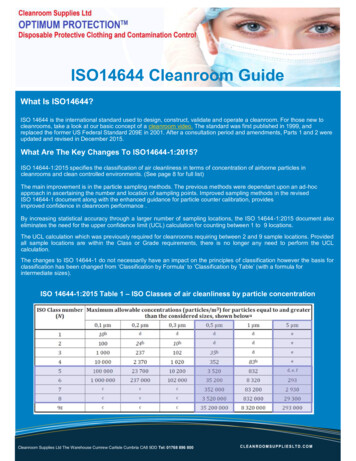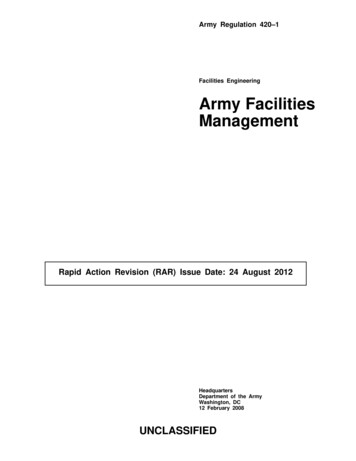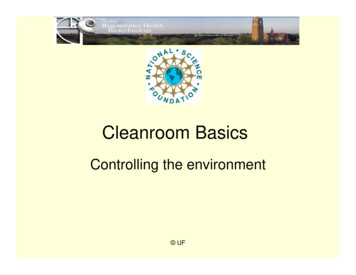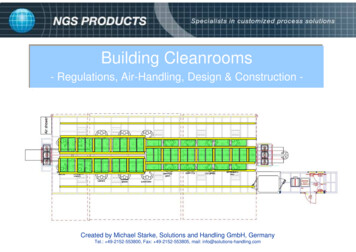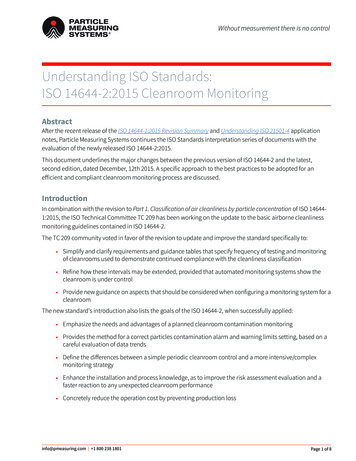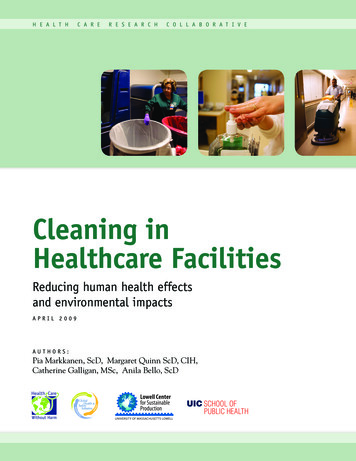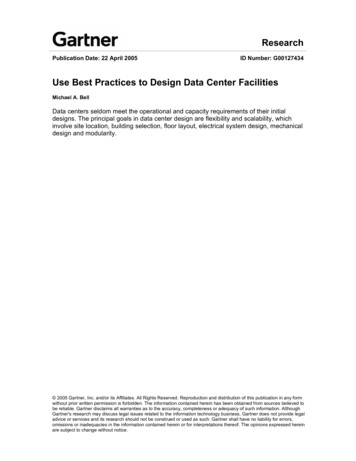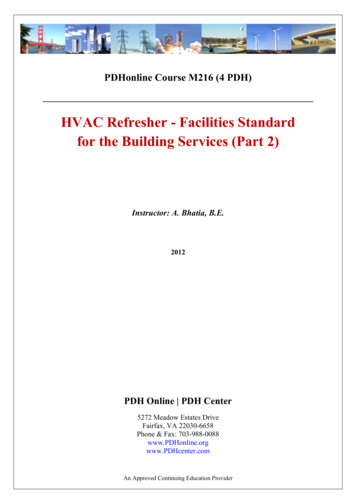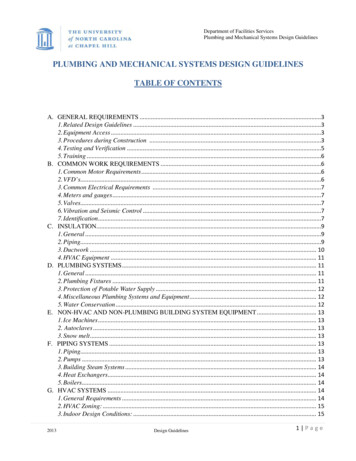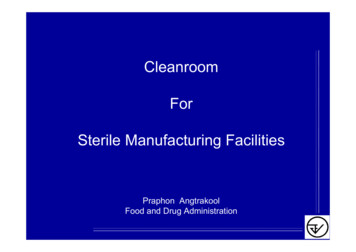
Transcription
CleanroomForSterile Manufacturing FacilitiesPraphon AngtrakoolFood and Drug Administration
WHO TRS No. 823 Annex 1, 1992 (1)General17.1 The production of sterile preparations should be carried outin clean areas, entry to which should be through airlocks forpersonnel and/or for goods. Clean areas should bemaintained to an appropriate standard of cleanliness andsupplied with air that has passed through filters of anappropriate efficiency.17.2 The various operations of component preparation (such ascontainers and closures), product preparation, filling andsterilization should be carried out in separate areas within aclean area.17.3 Clean areas for the production of sterile products areclassified according to the required characteristics of the air,in grades A, B, C and D (see Table 1)1
WHO TRS No. 823 Annex 1, 1992 (2)Table 1. Air classification system for manufacture of sterile productsMaximum number of particlepermitted per m30.5 – 5 µm 5 µmMaximumnumber of viablemicro-organismper m3A(Laminar airflowworkstation)3 500NoneLess than 1B3 500None5C350 0002 000100D3 500 00020 000500Grade2
WHO TRS No. 823 Annex 1, 1992 (3)GeneralTo obtain air of the required characteristics, methods specified bythe national authorities should be used. It should be noted that :¡Laminar airflow systems should provide a homogeneous airspeed of about 0.30 m/s for vertical flow and about 0.45 m/sfor horizontal flow but precise air speeds will depend on thetype of equipment.¡In order to reach the B, C and D air grades, the number of airchanges should generally be higher than 20 per hour in aroom with a good airflow pattern and appropriate HEPA(high-efficiency particulate air) filters.3
WHO TRS No. 823 Annex 1, 1992 (4)General Low values for contaminants are reliable only when alarge number of air samples are taken.¡The guidance given for the maximum permittednumber of particles corresponds approximately to theUnited States Federal Standard 209 E (1992) asfollows : Class 100 (grades A and B), Class 10 000(grade C), and Class 100 000 (grade D)It may not always be possible to demonstrate conformity withparticular air standards at the point of fill when filling is inprogress, owing to the generation of particles or droplets fromthe product itself.4
WHO TRS No. 823 Annex 1, 1992 (5)Manufacture of sterile preparations17.5 Manufacturing operations are here divided into three categories :first, those in which the preparation is seal in its final container andterminally sterilized; second, those in which the preparation issterilized by filtration; and third, those in which the preparation canbe sterilized neither by filtration nor terminally and consequentlymust be produced from sterile starting materials in an aseptic way.Area grades as specified in section 17.5.1 – 17.5.3, must beselected by the manufacturer on the basis of validation runs (e.g.,sterile media fills)5
WHO TRS No. 823 Annex 1, 1992 (6)Terminally sterilized products17.5.1 Solutions should generally be prepared in a grade C environmentin order to give low microbial and particulate counts, suitable forimmediate filtration and sterilization. Solution preparation could beallowed in a grade D environment if additional measures weretaken to minimize contamination, such as the use of closedvessels. For parenterals, filling should be done in a laminar airflowworkstation (grade A) in a grade C environment. The preparationof other sterile products, e.g., ointments, creams, suspensionsand emulsions, and filling of containers should generally be donein a grade C environment before terminal sterilization.6
WHO TRS No. 823 Annex 1, 1992 (7)Other sterile filtered products prepared from sterile materialsin an aseptic way17.5.2 The handling of starting materials and all further processingshould be done in a grade A or B area with a grade B or Cbackground respectively.7
WHO TRS No. 823 Annex 1, 1992 (8)Typical Air Quality Classification (WHO TRS 823, 1992)Typical Process StepTerminally SterilizedSterile FilteredAseptically ProcessedHandling of sterile startingmaterialsGrade C oruse closed vessels inGrade D BackgroundGrade C oruse closed vessels inGrade D BackgroundGrade A or B(Background Grade Bor C respectively)Preparation of solutionsGrade C oruse closed vessels inGrade D BackgroundGrade C oruse closed vessels inGrade D BackgroundGrade A or B(Background Grade Bor C respectively)FillingGrade ABackground Grade C(Parenteral)Grade A or B(Background Grade Bor C respectively)Grade A or B(Background Grade Bor C respectively)Grade CGrade A or B(Background Grade Bor C respectively)Preparation and filling ofointments, emulsions,creams and suspensionsGrade C8
PIC/S,1 July 2004 (1)GENERAL1.The manufacture of sterile products should be carried outin clean areas, entry to which should be through airlocksfor personnel and/or for equipment and materials. Cleanareas should be maintained to an appropriate cleanlinessstandard and supplied with air which has passed throughfilters of an appropriate efficiency.2.The various operations of component preparation, productpreparation and filling should be carried out in separateareas within the clean area. Manufacturing operations aredivided into two categories; firstly those where the productis terminally sterilised, and secondly those which areconducted aseptically at some or all stages.9
WHO, TRS 902 Annex 6, 2002 (1)1.General considerations1.1 The production of sterile preparations should be carried out inclean areas, entry to which should be through airlocks forpersonnel and/or for equipment and materials. Clean areasshould be maintained to an appropriate standard of cleanlinessand supplied with air that has passed through filters of therequired efficiency.1.2 The various operations of component preparation (such as thoseinvolving containers and closures), product preparation, fillingand sterilization should be carried out in separate areas within aclean area. These areas are classified into four grades (seesection 4.1).1.3 Manufacturing operations are divided here into two categories :first, those where the product is terminally sterilized, and second,those which are conducted aseptically at some or all stages.10
PIC/S,1 July 2004 (2)GENERAL3 Clean areas for the manufacture of sterile products are classifiedaccording to the required characteristics of the environment.Each manufacturing operation requires an appropriateenvironmental cleanliness level in the operational state in orderto minimize the risks of particulate or microbial contamination ofthe product or materials being handled.In order to meet “in operation” conditions these areas should bedesigned to reach certain specified air-cleanliness levels in the“at rest” occupancy state. The “at rest” state is the conditionwhere the installation is installed and operating, complete withproduction equipment but with no operating personnel present.The “in operation” state is the condition where the installation isfunctioning in the defined operating mode with the specifiednumber of personnel working.11
WHO, TRS 902 Annex 6, 2002 (2)4. Manufacture of sterile preparations4.1 Clean areas for the manufacture of sterile products are classifiedaccording to the required characteristics of the environment. Eachmanufacturing operation requires an appropriate environmentalcleanliness level in the operational state in order to minimize therisks of particulate or microbiological contamination of the productor materials being handled.In order to meet “in operation” conditions, these areas should bedesigned to reach certain specified air cleanliness levels in the “atrest” occupancy state. This latter state is the condition where theinstallation is complete, and production equipment has beeninstalled and is operating, but no operating personnel are present.The “in operation” state is the condition where the installation isfunctioning in the defined operating mode and the specifiednumber of personnel are present.12
PIC/S,1 July 2004 (3)GENERALFor the manufacture of sterile medicinal products 4 grades can bedistinguished.Grade A: The local zone for high risk operations, e.g. filling zone,stopper bowls, open ampoules and vials, making asepticconnections. Normally such conditions are provided by a laminarair flow work station. Laminar air flow systems should provide ahomogeneous air speed in a range of 0.36 – 0.54 m/s (guidancevalue) at the working position in open clean room applications. Themaintenance of laminarity should be demonstrated and validated.A uni-directional air flow and lower velocities may be used inclosed isolators and glove boxes.Grade B: For aseptic preparation and filling, this is the backgroundenvironment for grade A zone.Grade C and D: Clean areas for carrying out less critical stages inthe manufacture of sterile products.13
WHO, TRS 902 Annex 6, 2002 (3)4. Manufacture of sterile preparationsFor the manufacture of sterile pharmaceutical preparations, fourgrades are distinguished here, as follows:¡ Grade A : The local zone for high-risk operations, e.g. filling andmaking aseptic connections. Normally such conditions areprovided by a laminar airflow workstation. Laminar airflow systemsshould provide a homogeneous air speed of approximately 0.45m/s. 20% (guidance value) at the working position.¡ Grade B : In aseptic preparation and filling, the backgroundenvironment for the grade A zone.¡ Grades C and D : Clean areas for carrying out less critical stagesin the manufacture of sterile products.The airborne particulate classification for the four grades is given inTable 2.14
PIC/S,1 July 2004 (4)The airborne particulate classification for these grades is given inthe following table.At rest (b)GradeIn operation (b)Maximum permitted number of particles/m 3Equal to or above (a)0.5 µm (d)0.5 µm (d)5 µm5 µmA35001 (e)35001 (d)B (c)35001 (e)350 0002000C (c)350 00020003 500 00020 000D (c)3 500 00020 000 Not defined (f) Not defined (d)15
WHO, TRS 902 Annex 6, 2002 (4)Table 2 : Airborne particulate classification for manufacture of sterile pharmaceutical preparationsGradeAt restIn operationMaximum number of particlespermitted/m 3Maximum number of particlespermitted/m 30.5 – 5.0 µm0.5 – 5.0 µm 5.0 µm 5.0 µmA3500035000B35000350 0002000C350 00020003 500 00020 000D3 500 00020 000Not definedNot defined16
PIC/S,1 July 2004 (5)Notes :(a) Particle measurement based on the use of a discrete airborne particlecounter to measure the concentration of particles at designated sizes equalto or greater than the threshold stated. A continuous measurement systemshould be used for monitoring the concentration of particles in the grade Azone, and is recommended for the surrounding grade B areas. For routinetesting the total sample volume should not be less than 1 m³ for grade Aand B areas and preferably also in grade C areas.(b) The particulate conditions given in the table for the “at rest” state should beachieved after a short “clean up” period of 15-20 minutes (guidance value)in an unmanned state after completion of operations. The particulateconditions for grade A “in operation” given in the table should be maintainedin the zone immediately surrounding the product whenever the product oropen container is exposed to the environment. It is accepted that it may notalways be possible to demonstrate conformity with particulate standards atthe point of fill when filling is in progress, due to the generation of particlesor droplets from the product itself.17
WHO, TRS 902 Annex 6, 2002 (5)4.Manufacture of sterile preparations4.2 The particulate conditions given in Table 2 for the “at rest” stateshould be achieved in the absence of the operating personnelafter a short “clean-up” period of about 15 – 20 minutes(guidance value), after completion of the operations. Theparticulate conditions given in Table 2 for grade A “inoperation” should be maintained in the zone immediatelysurrounding the product whenever the product or opencontainer is exposed to the environment. It is accepted that itmay not always be possible to demonstrate conformity withparticulate standards at the point of fill when filling is inprogress, owing to the generation of particles or droplets fromthe product itself.18
PIC/S,1 July 2004 (6)(c) In order to reach the B, C and D air grades, the number of air changesshould be related to the size of the room and the equipment andpersonnel present in the room. The air system should be provided withappropriate terminal filters such as HEPA for grades A, B and C.(d) The guidance given for the maximum permitted number of particles in the“at rest” and “in operation” conditions correspond approximately to thecleanliness classes in the EN/ISO 14644-1 at a particle size of 0.5 mm.(e) These areas are expected to be completely free from particles of sizegreater than 5 µm. As it is impossible to demonstrate the absence ofparticles with any statistical significance, the limits are set to 1 particle/m3During the clean room qualification it should be shown that the areas canbe maintained within the defined limits.(f) The requirements and limits will depend on the nature of the operationscarried out.19
WHO, TRS 902 Annex 6, 2002 (6)4. Manufacture of sterile preparationsTo obtain air of the required characteristics, methods specified bynational authorities should be used. It should be noted that:¡ In order to reach the B, C and D air grades, the number of airchanges should be appropriate for the size of the room and theequipment and personnel present in it. At least 20 air changes perhour are usually required for a room with a good airflow patternand appropriate high-efficiency particulate air (HEPA) filters.¡ Detailed information on methods for determining themicrobiological and particulate cleanliness of air, surfaces, etc. isnot given here. Reference should be made to other guidelinespublished in compendia such as the European, Japanese orUnited States pharmacopoeias, or in docum
value) at the working position in open clean room applications. The maintenance of laminarity should be demonstrated and validated. A uni-directional air flow and lower velocities may be used in closed isolators and glove boxes. Grade B: For aseptic preparation and filling, this is the background environment for grade A zone. Grade C and D: Clean areas for carrying out less critical stages in .
